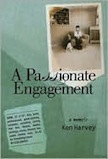 A Passionate Engagement
A Passionate Engagement
by Ken Harvey
Pleasure Boat Studio. 199 pages, $18.
THE STRUGGLE for marriage equality is something we all support, and marriage is a state that many gay couples embrace. But what about the wedding ceremony itself, a rite of passage that has come to be invested with the promise of eternal love, fidelity, happiness? For writer Ken Harvey, author of the award-winning book, If You Were With Me, Everything Would Be All Right, getting legally married to his partner Bruce, whom he met through a personal ad in The Boston Phoenix, was life’s “Be all moment.” That moment is the basis for Harvey’s memoir, A Passionate Engagement, which follows Ken and Bruce as they come to grips with whether to marry legally once their home state of Massachusetts makes it possible.
In this memoir, Harvey weaves his own story with the equally compelling drama taking place in the Boston State House, where a pitched battle between pro- and anti-marriage equality forces was unleashed the moment the commonwealth’s highest court legalized same-sex marriage. But Ken’s interest in getting married began in 2002 when The New York Times announced its decision to list same-sex commitment ceremonies. “I remember waiting for The Times the Sunday morning of the first same-sex commitment announcements,” he writes. An out teacher at a posh school where his gay-friendly students casually quiz him on the GLBT issues of the day, Ken is a good match for his businessman-investor partner Bruce. Together they work hard at their relationship, and in fact they do so well at it that one could imagine them as poster boys for a Human Rights Campaign campaign promoting marriage equality.
Decent, hard-working citizens that Ken and Bruce are, we want their love to flourish. Their ten-year loyalty to one another is commendable. Still, there’s a feeling that both men see the marriage ceremony as some kind of magic wand that will do more than just give them the benefits that straight couples enjoy. Ken comes to realize this, writing: “I’d begun to base the future of our relationship on whether or not we’d be able to marry. If we can’t marry, then we might not last, went the thought bubble. I knew I was giving the government far too much power over our relationship, but I couldn’t help it.” There’s the inevitable comparison to his parents’ marriage: “I told myself our marriage would be better than the ones we both had seen our parents struggle through, more honest than the one Bruce had with a woman before he understood his sexuality.”
As the legislative battles to amend the Massachusetts constitution intensify, Ken worries about the ugly backlash in the form of Dr. Laura and Rush Limbaugh. Even watching TV, he confesses, becomes a downer: “I couldn’t even watch politicians on my side try and convince the public that ‘gay people are people, just like you and me.’ It was terribly draining, even degrading, to watch myself being defended on TV.” The stress escalates as anti-gay pundits, politicians, and clergymen like Boston’s Archbishop O’Malley wage war on marriage equality. Through it all, Ken and Bruce press forward with their ceremony plans despite the fact that it could all be undone by forces beyond their control, their ceremony reduced to ashes.
They also face questions about which caterer to use, how many people to invite, and how formal to make the event. This escape into Martha Stewartville, I admit, held a certain fascination for me, but I know it’s not for everyone. As a reader, I felt a part of their shared intimacy, and I admired how well these two men worked together as a team, their story a sort of “hard knocks” fairy tale without too much saccharine. And yet, under the surface of all this happiness, there always seemed to loom a quiet, potential threat, the dark side of marriage—infidelity, jealousy, divorce—that they were trying awfully hard to keep at bay.
________________________________________________________
Thom Nickels, a Philadelphia writer, is the author of Philadelphia Architecture, Out in History, and the recently released Spore.





